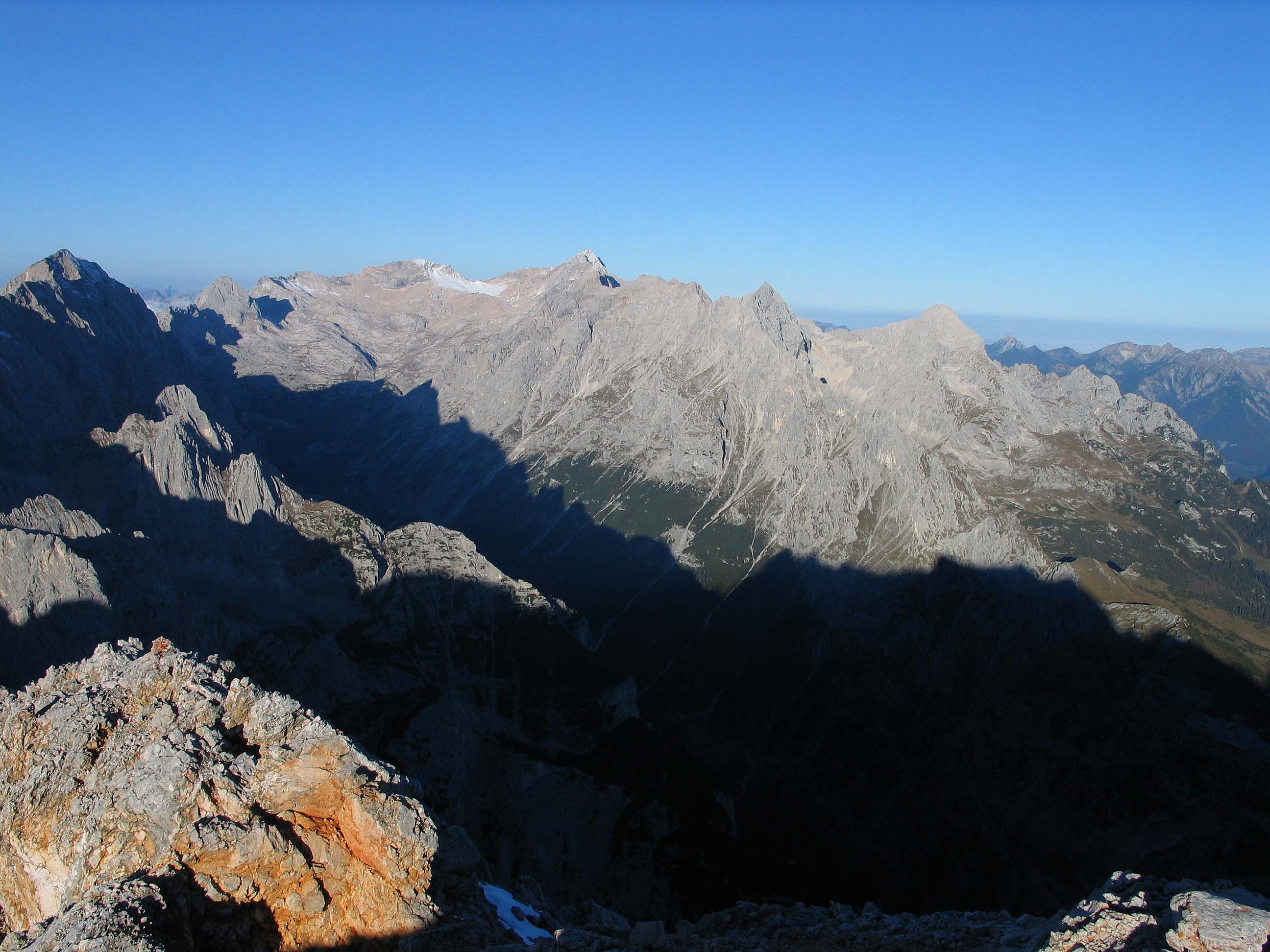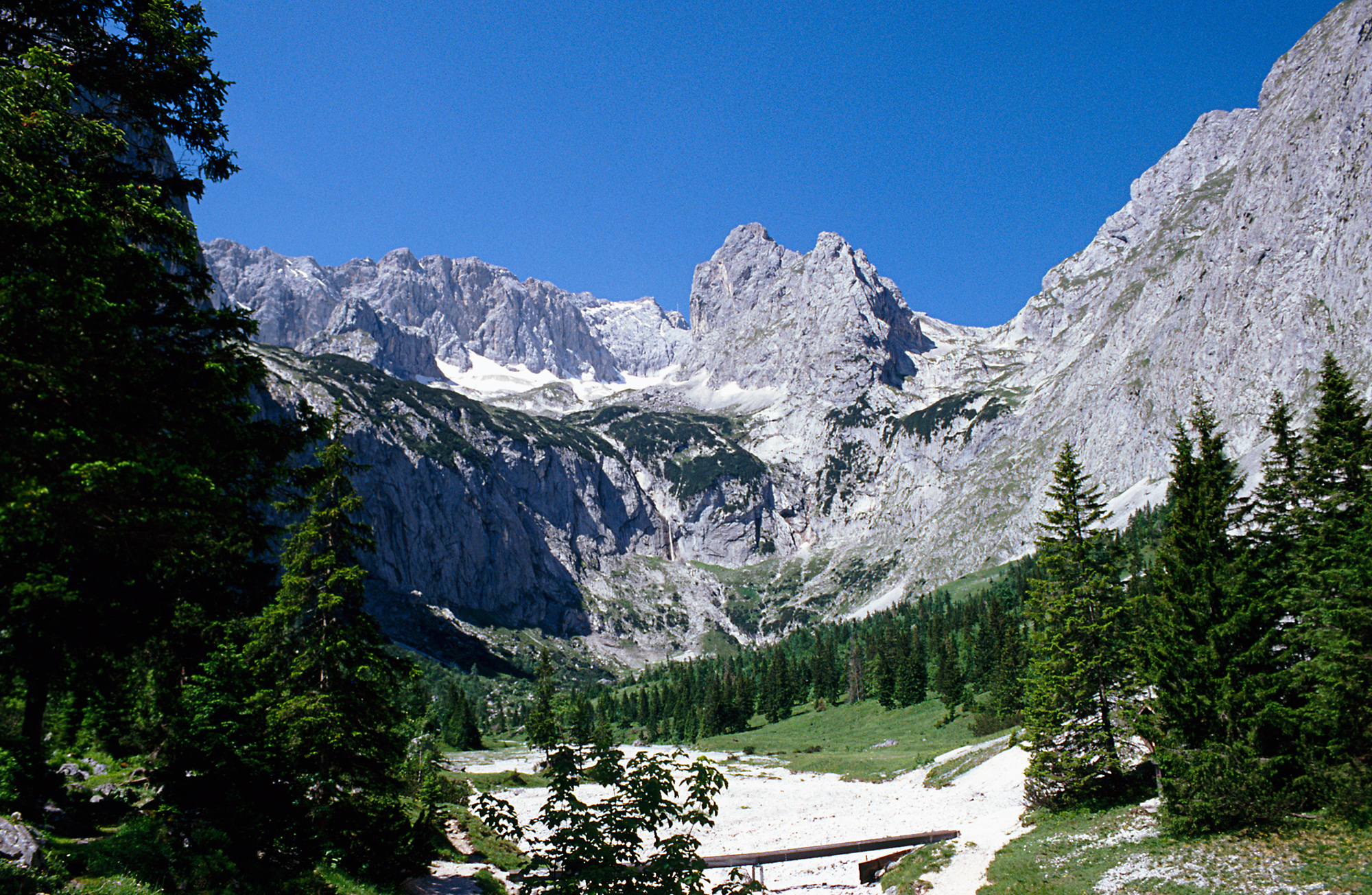|
Riffelspitzen
The Riffelspitzen are two neighbouring peaks in the Wetterstein range in Bavaria. The Southern Riffelspitze (german: Südliche Riffelspitze) is 2,263 m high; the Northern Riffelspitze (''Nördliche Riffelspitze'') attains 2,242 m.Bundesamt für Kartographie und Geodäsie, Landesamt für Vermessung und Geoinformation Bayern: digitale topographische map 1:50,000BayernViewer, accessed on 23 September 2010 Situation The Riffelspitzen rise from the ridge of the Waxensteinkamm in the northern Wetterstein Mountains. To the north is the lake of Eibsee, to the south runs the Höllental. The next mountain to the southwest is the Riffeltorkopf (2,230 m), which is separated from by the knife-edge of the 2,163 m high ''Riffelscharte''. To the northeast the ridge continues to the 2,264 m high ''Schönangerspitze''. Whilst on the southern side grassy slopes, punctuated by rocky ''schrofen'', run almost to the summit ridge, on the northern side, bare rock faces drop ... [...More Info...] [...Related Items...] OR: [Wikipedia] [Google] [Baidu] |
Wetterstein Mountains
The Wetterstein mountains (german: Wettersteingebirge), colloquially called Wetterstein, is a mountain group in the Northern Limestone Alps within the Eastern Alps. It is a comparatively compact range located between Garmisch-Partenkirchen, Mittenwald, Seefeld in Tirol and Ehrwald along the border between Germany (Bavaria) and Austria (Tyrol). Zugspitze, the highest peak is at the same time the highest mountain in Germany. The Wetterstein mountains are an ideal region for mountaineers and climbers. Mountain walkers sometimes need to allow for significant differences in elevation. The proximity of the range to the south German centres of population, the scenic landscape and its good network of cable cars and lifts mean that the mountains are heavily frequented by tourists for most of the year. There are, however, places in the Wetterstein that are rarely or never visited by people. Neighbouring ranges The Wetterstein borders on the following other mountain ranges of t ... [...More Info...] [...Related Items...] OR: [Wikipedia] [Google] [Baidu] |
Bergverlag Rother
Bergverlag Rother is a German publisher with its headquarters in Oberhaching, Upper Bavaria. Since 1950 the company, that formerly went under the name of ''Bergverlag Rudolf Rother'', has published the Alpine Club Guides in cooperation with the German Alpine Club (DAV), the Austrian Alpine Club (ÖAV) and the South Tyrol Alpine Club. Rother publish a "famous series of English language guides" covering most of the popular walking destinations in the Alps and Europe. History The company was founded on 16 November 1920 in Munich Munich ( ; german: München ; bar, Minga ) is the capital and most populous city of the States of Germany, German state of Bavaria. With a population of 1,558,395 inhabitants as of 31 July 2020, it is the List of cities in Germany by popu ... by Rudolf Rother sen., a bookseller and mountaineer, and is one of the oldest and most important specialist Alpine publishers. [...More Info...] [...Related Items...] OR: [Wikipedia] [Google] [Baidu] |
Climbing Grade
In rock climbing, mountaineering, and other climbing disciplines, climbers give a grade to a climbing route or boulder problem, intended to describe concisely the difficulty and danger of climbing it. Different types of climbing (such as sport climbing, bouldering or ice climbing) each have their own grading systems, and many nationalities developed their own, distinctive grading systems. There are a number of factors that contribute to the difficulty of a climb, including the technical difficulty of the moves, the strength, stamina and level of commitment required, and the difficulty of protecting the climber. Different grading systems consider these factors in different ways, so no two grading systems have an exact one-to-one correspondence. Climbing grades are inherently subjective.Reynolds Sagar, Heather, 2007, ''Climbing your best: training to maximize your performance'', Stackpole Books, UK, 9. They may be the opinion of one or a few climbers, often the first ascensi ... [...More Info...] [...Related Items...] OR: [Wikipedia] [Google] [Baidu] |
Höllentalanger Hut
The Höllentalanger Hut (1,381 m) is a managed hut owned by the German Alpine Club in the Wetterstein Mountains of Bavaria, in the district of Garmisch-Partenkirchen. The hut lies in a narrow defile between the Höllental-Blassen and Waxenstein-Riffelwand crest and is open from the end of May to mid-October. It has more than 80 bedspaces. Its predecessor, with 80 bedspaces, was demolished in September 2013 in order to make way for an entirely new hut. It was built in 2014/15 and opened on 23 August 2015. History The Hut category, category 1 hut was built in 1894 and has had its present appearance since 1925 when it was extended. Since 2004 a completely new hut has been in planning. The cost of construction has been assessed by the German Alpine Club at €2.3M. The new hut is intended to take the extreme avalanche situation in the Höllental into account. The winter room was closed by the authorities in 2004 or 2005 due to the avalanche danger in winter. The demolition of the o ... [...More Info...] [...Related Items...] OR: [Wikipedia] [Google] [Baidu] |
Ehrwald
Ehrwald is a municipality in the district of Reutte in the Austrian state of Tyrol. Geography Ehrwald lies at the southern base of the Zugspitze (2950 meters above sea level), Germany's highest mountain, but which is shared with Austria. The town is connected to the Zugspitze with the Tyrolean Aerial Tramway. Climate Ehrwald has a humid continental climate (Dfb DFB may refer to: * Deerfield Beach, Florida, a city * Decafluorobutane, a fluorocarbon gas * Dem Franchize Boyz, former hip hop group, Atlanta, Georgia * Dfb, Köppen climate classification for Humid continental climate * Distributed-feedback ...) with four distinct seasons. Summers are very pleasant, with mild to warm days and cool nights. Winters are relatively cold and snowy, with average annual snowfall totalling 128 inches (325 cm). Precipitation is very reliable year round, but markedly more so during the summer months. References External links Cities and towns in Reutte District {{Tyrol-geo- ... [...More Info...] [...Related Items...] OR: [Wikipedia] [Google] [Baidu] |
Klettersteig
A via ferrata (Italian language, Italian for "iron path", plural ''vie ferrate'' or in English ''via ferratas'') is a protected climbing route found in the Alps and certain other locations. The term "via ferrata" is used in most countries and languages except notably in German-speaking regions, which use ''Klettersteig''—"climbing path" (plural ''Klettersteige''). Infrastructure A via ferrata is a climbing route that employs steel cables, rungs or ladders, fixed to the rock to which the climbers affix #Safety and equipment, a harness with two leashes, which allows the climbers to secure themselves to the metal fixture and limit any fall. The cable and other fixtures, such as iron rungs (stemples), pegs, carved steps, and ladders and bridges, provide both footings and handholds, as well. This allows climbing on otherwise dangerous routes without the risks of unprotected scrambling and climbing or the need for technical climbing equipment. They expand the opportunities for acce ... [...More Info...] [...Related Items...] OR: [Wikipedia] [Google] [Baidu] |
Schrofen
Schrofen, a German mountaineering term, is steep terrain, strewn with rocks and rock outcrops, that is laborious to cross, but whose rock ledges (''schrofen'') offer many good steps and hand holds. It is usually rocky terrain on which grass has established itself, but it can also refer to purely rocky slopes. ''Schrofen'' are found especially where the rock has broken off against its angle of dip. ''Schrofen'' differs from trackless terrain in that hands are needed in order to negotiate it. Often there are route markings that only indicate a rough direction. ("How to negotiate ''schrofen'' terrain safely") at www.alpin.de. Accessed on 31 Dec 2010 ''Schrofen'' terrain requires at least |
Höllental (Wetterstein)
The ''Höllental'', English translation "Hell Valley" or "Valley of Hell" is one of the routes on the German side leading up the Zugspitze on the German-Austrian border in the northern Alps. It is located in the district of Garmisch-Partenkirchen. See also *Zugspitze The Zugspitze (), at above sea level, is the highest peak of the Wetterstein Mountains as well as the highest mountain in Germany. It lies south of the town of Garmisch-Partenkirchen, and the Austria–Germany border runs over its western su ... * Höllental on the German Wikipedia ZUGSPITZE 360° atop the Zugspitze via the Höllental External links Valleys of the Alps Valleys of Bavaria Canyons and gorges of Germany {{GarmischPartenkirchendistrict-geo-stub ... [...More Info...] [...Related Items...] OR: [Wikipedia] [Google] [Baidu] |
Bavaria
Bavaria ( ; ), officially the Free State of Bavaria (german: Freistaat Bayern, link=no ), is a state in the south-east of Germany. With an area of , Bavaria is the largest German state by land area, comprising roughly a fifth of the total land area of Germany. With over 13 million inhabitants, it is second in population only to North Rhine-Westphalia, but due to its large size its population density is below the German average. Bavaria's main cities are Munich (its capital and largest city and also the third largest city in Germany), Nuremberg, and Augsburg. The history of Bavaria includes its earliest settlement by Iron Age Celtic tribes, followed by the conquests of the Roman Empire in the 1st century BC, when the territory was incorporated into the provinces of Raetia and Noricum. It became the Duchy of Bavaria (a stem duchy) in the 6th century AD following the collapse of the Western Roman Empire. It was later incorporated into the Holy Roman Empire, became an ind ... [...More Info...] [...Related Items...] OR: [Wikipedia] [Google] [Baidu] |
Eibsee
Eibsee ("yew lake") is a lake in Bavaria, Germany, 9 km southwest of Garmisch-Partenkirchen and roughly 100 km southwest of Munich. It is above sea-level and its surface area is . It is at the northerly base of the Zugspitze ( above sea level and 3.5 km to the south), Germany's highest mountain. The lake lies within the municipality of Grainau and is privately-owned. Hydrology The northeast corner of the Eibsee is known as the Untersee. With an area of 4.8 hectares, and 26 meters depth, it is almost completely separated from the main part of the lake, the Weitsee (172 hectares) by a 50-meter-wide and only 0.5-meter-deep narrow point. A hiking trail leads over a small bridge at this narrow point along the north bank of the Eibsee. The deepest point of the entire lake, at 34.5 meters, is only about 90 meters from the southeastern shore (across from the nearby Frillensee). The completely-separated small neighboring lakes include the Frillensee in the south (not to ... [...More Info...] [...Related Items...] OR: [Wikipedia] [Google] [Baidu] |
Waxenstein
Waxenstein is a mountain of Bavaria, Germany Germany,, officially the Federal Republic of Germany, is a country in Central Europe. It is the second most populous country in Europe after Russia, and the most populous member state of the European Union. Germany is situated betwe .... Mountains of Bavaria Mountains of the Alps {{Bavaria-geo-stub ... [...More Info...] [...Related Items...] OR: [Wikipedia] [Google] [Baidu] |




